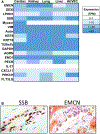Discovery of non-HLA antibodies associated with cardiac allograft rejection and development and validation of a non-HLA antigen multiplex panel: From bench to bedside
- PMID: 32185871
- PMCID: PMC7494540
- DOI: 10.1111/ajt.15863
Discovery of non-HLA antibodies associated with cardiac allograft rejection and development and validation of a non-HLA antigen multiplex panel: From bench to bedside
Abstract
We analyzed humoral immune responses to nonhuman leukocyte antigen (HLA) after cardiac transplantation to identify antibodies associated with allograft rejection. Protein microarray identified 366 non-HLA antibodies (>1.5 fold, P < .5) from a discovery cohort of HLA antibody-negative, endothelial cell crossmatch-positive sera obtained from 12 cardiac allograft recipients at the time of biopsy-proven rejection. From these, 19 plasma membrane proteins and 10 autoantigens identified from gene ontology analysis were combined with 48 proteins identified through literature search to generate a multiplex bead array. Longitudinal sera from a multicenter cohort of adult cardiac allograft recipients (samples: n = 477 no rejection; n = 69 rejection) identified 18 non-HLA antibodies associated with rejection (P < .1) including 4 newly identified non-HLA antigenic targets (DEXI, EMCN, LPHN1, and SSB). CART analysis showed 5/18 non-HLA antibodies distinguished rejection vs nonrejection. Antibodies to 4/18 non-HLA antigens synergize with HLA donor-specific antibodies and significantly increase the odds of rejection (P < .1). The non-HLA panel was validated using an independent adult cardiac transplant cohort (n = 21 no rejection; n = 42 rejection, >1R) with an area under the curve of 0.87 (P < .05) with 92.86% sensitivity and 66.67% specificity. We conclude that multiplex bead array assessment of non-HLA antibodies identifies cardiac transplant recipients at risk of rejection.
Keywords: autoantibody; autoantigen; clinical research/practice; heart transplantation/cardiology; histocompatibility; immunogenetics; microarray/protein array; organ transplantation in general; rejection; translational research/science.
© 2020 The American Society of Transplantation and the American Society of Transplant Surgeons.
Conflict of interest statement
DISCLOSURE
The authors of this manuscript have conflicts of interest to disclose as described by the
Figures








Comment in
-
Rejection in the setting of non-HLA antibody: New tools for navigating bench to bedside.Am J Transplant. 2020 Oct;20(10):2639-2641. doi: 10.1111/ajt.15975. Epub 2020 May 25. Am J Transplant. 2020. PMID: 32372531 No abstract available.
Similar articles
-
Interplay between immune responses to HLA and non-HLA self-antigens in allograft rejection.Hum Immunol. 2013 Nov;74(11):1478-85. doi: 10.1016/j.humimm.2013.07.002. Epub 2013 Jul 19. Hum Immunol. 2013. PMID: 23876679 Free PMC article. Review.
-
Profiling non-HLA antibody responses in antibody-mediated rejection following heart transplantation.Am J Transplant. 2020 Sep;20(9):2571-2580. doi: 10.1111/ajt.15871. Epub 2020 Apr 26. Am J Transplant. 2020. PMID: 32190967 Free PMC article.
-
Association of vimentin antibody and other non-HLA antibodies with treated antibody mediated rejection in heart transplant recipients.Hum Immunol. 2020 Dec;81(12):671-674. doi: 10.1016/j.humimm.2020.09.003. Epub 2020 Oct 9. Hum Immunol. 2020. PMID: 33041085
-
Flow cytometric detection of HLA-specific antibodies as a predictor of heart allograft rejection.Transplantation. 2000 Oct 15;70(7):1055-9. doi: 10.1097/00007890-200010150-00011. Transplantation. 2000. PMID: 11045642
-
Management of children undergoing cardiac transplantation with high Panel Reactive Antibodies.Cardiol Young. 2011 Dec;21 Suppl 2:124-32. doi: 10.1017/S1047951111001703. Cardiol Young. 2011. PMID: 22152539 Review.
Cited by
-
Antibody-independent microvascular inflammation impacts long-term risk in heart transplantation.medRxiv [Preprint]. 2025 Jul 29:2025.07.29.25332346. doi: 10.1101/2025.07.29.25332346. medRxiv. 2025. PMID: 40766116 Free PMC article. Preprint.
-
Extracellular Vesicles Mediate Immune Responses to Tissue-Associated Self-Antigens: Role in Solid Organ Transplantations.Front Immunol. 2022 Apr 27;13:861583. doi: 10.3389/fimmu.2022.861583. eCollection 2022. Front Immunol. 2022. PMID: 35572510 Free PMC article. Review.
-
Impact of everolimus plus calcineurin inhibitor on formation of non-HLA antibodies and graft outcomes in kidney transplant recipients: 12-month results from the ATHENA substudy.Front Transplant. 2023 Nov 21;2:1273890. doi: 10.3389/frtra.2023.1273890. eCollection 2023. Front Transplant. 2023. PMID: 38993854 Free PMC article.
-
Vascular and Non-HLA autoantibody profiles in hospitalized patients with COVID-19.Front Immunol. 2023 Jun 15;14:1197326. doi: 10.3389/fimmu.2023.1197326. eCollection 2023. Front Immunol. 2023. PMID: 37398658 Free PMC article.
-
Donor-Specific Antibody Testing is an Effective Surveillance Strategy for High-Risk Antibody Mediated Rejection in Heart Transplant Patients in the Contemporary Era.medRxiv [Preprint]. 2024 Oct 1:2023.12.01.23299311. doi: 10.1101/2023.12.01.23299311. medRxiv. 2024. Update in: J Heart Lung Transplant. 2025 Jul;44(7):1036-1049. doi: 10.1016/j.healun.2025.01.019. PMID: 38106112 Free PMC article. Updated. Preprint.
References
-
- Stehlik J, Edwards LB, Kucheryavaya AY, et al. The Registry of the International Society for Heart and Lung Transplantation: 29th official adult heart transplant report–2012. J Heart Lung Transplant. 2012;31(10):1052–1064. - PubMed
-
- Colvin-Adams M, Smith JM, Heubner BM, et al. OPTN/SRTR 2013 annual data report: heart. Am J Transplant. 2015;15(Suppl 2):1–28. - PubMed
-
- Tible M, Loupy A, Vernerey D, et al. Pathologic classification of antibody-mediated rejection correlates with donor-specific antibodies and endothelial cell activation. J Heart Lung Transplant. 2013;32(8):769–776. - PubMed
-
- Tait BD, Süsal C, Gebel HM, et al. Consensus guidelines on the testing and clinical management issues associated with HLA and non-HLA antibodies in transplantation. Transplantation. 2013;95(1):19–47. - PubMed

